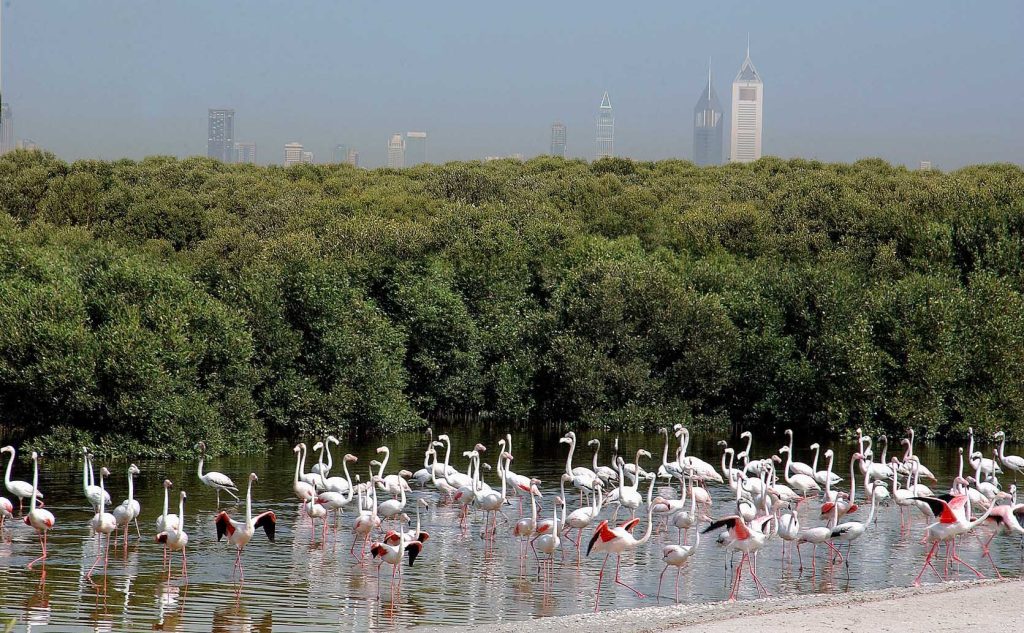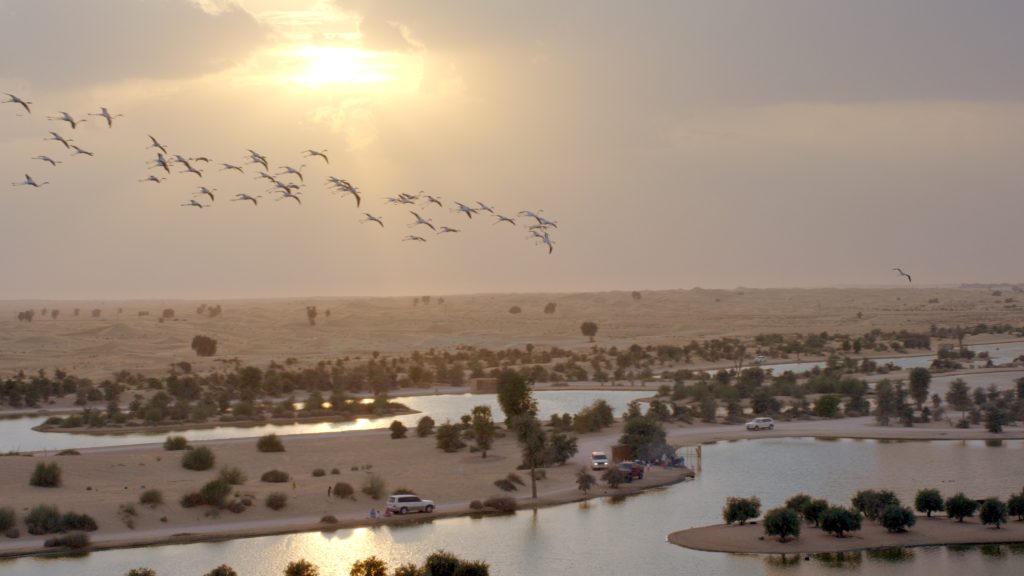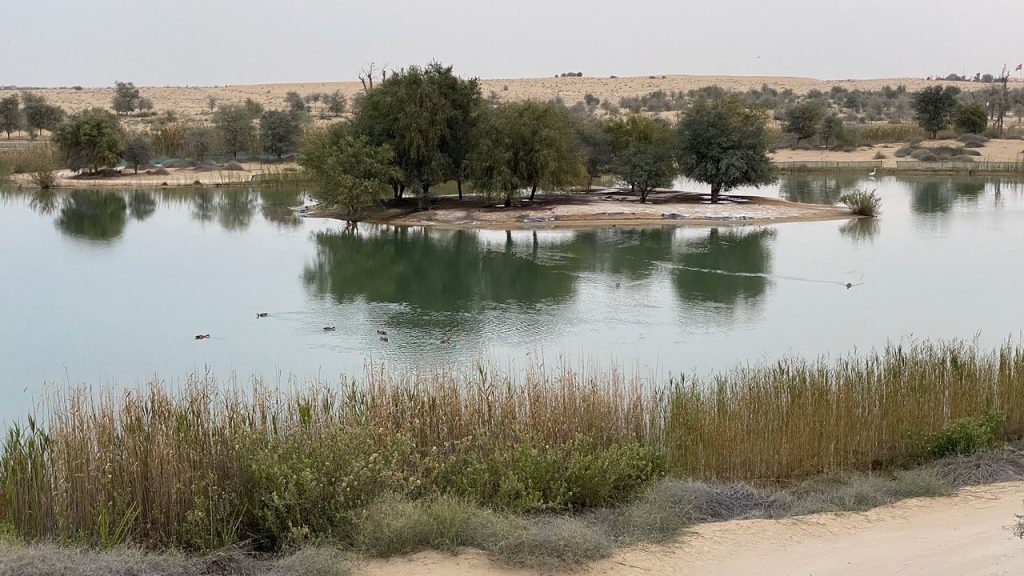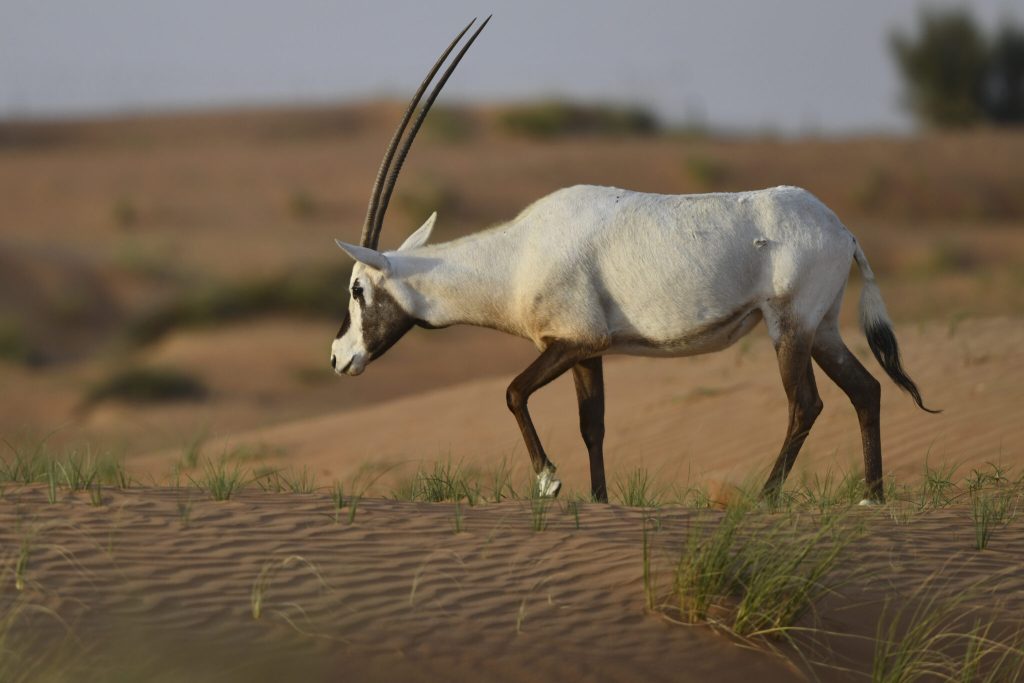Dubai isn’t just skyscrapers and shopping malls—it hides wild pockets waiting quietly beyond the city lines. Sand dunes breathe, lakes shimmer, and hidden trails lead to unexpected encounters. If you’re lucky, you might catch a flamingo mid-flight or a gazelle darting through golden silence. Nature still holds ground here, just far enough from the noise. These are the best places to see animals in the wild in Dubai—if you know where to look.
RAS AL KHOR WILDLIFE SANCTUARY
Nestled at Dubai Creek’s terminus, this sanctuary emerges as a verdant haven amid urban sprawl. Here, intertidal mudflats, mangroves, and lagoons coalesce, crafting a mosaic of habitats. Such diversity beckons a myriad of avian species, notably the flamboyant greater flamingos. These pink-hued birds, in synchronized elegance, wade through shallow waters, creating a mesmerizing tableau. Beyond flamingos, the sanctuary shelters over 450 animal species, including crustaceans and small mammals.
The flora isn’t to be overlooked, with 47 distinct plant species rooting the ecosystem. Bird enthusiasts find solace in the three strategically placed hides, offering intimate glimpses into avian life. Managed meticulously by Dubai Municipality, conservation efforts ensure the delicate balance remains undisturbed. Seasonal migrations transform the landscape, introducing species like the osprey and grey heron. The juxtaposition of serene nature against Dubai’s skyline offers a poignant reminder of coexistence.
For those seeking respite from urban clamor, this enclave provides a tranquil retreat. Observing the harmonious interplay of species here underscores the importance of urban conservation initiatives.

AL MARMOOM DESERT CONSERVATION RESERVE
Spanning over 40 hectares of shrubland and 10 kilometers of lakes, this reserve encompasses diverse ecosystems. It shelters more than 204 native bird species and 158 migratory ones. Notably, the Arabian oryx and Arabian gazelle roam its expanse. The reserve also boasts 26 reptile species and nine mammal species. Al Qudra Lakes, within the reserve, attract flocks of flamingos. Rare sightings include the Egyptian nightjar and the giant skipper butterfly. Managed by Dubai Municipality, conservation efforts are paramount. Visitors can explore observation platforms and an 84 km cycling track.
The Saruq Al Hadid archaeological site offers historical insights. Star gazing events capitalize on minimal light pollution. The reserve exemplifies Dubai’s commitment to biodiversity. Its proximity to the city offers an accessible nature escape. The juxtaposition of desert and wetlands creates unique habitats. Educational programs raise awareness about local wildlife. Al Marmoom serves as a model for sustainable ecotourism.

AL QUDRA LAKES
Nestled approximately 40 kilometers from Dubai’s bustling center, Al Qudra Lakes emerge as a serene desert oasis. This man-made marvel, spanning over 10 kilometers, comprises interconnected lakes and wetlands meticulously designed to support a thriving ecosystem. The area is a haven for over 170 bird species, including flamingos, swans, and various migratory birds. Visitors often spot desert foxes and the elusive Arabian oryx roaming the vicinity. Beyond wildlife observation, Al Qudra offers an 86-kilometer cycling track, attracting enthusiasts seeking a ride amidst picturesque desert landscapes.
The lakeside is also popular for picnics and barbecues, with designated areas ensuring a comfortable experience. Notably, the Love Lake, shaped like two interlocking hearts, adds a romantic touch to the setting. As night falls, the lack of light pollution makes it an ideal spot for stargazing. Whether you’re an avid birdwatcher, a cycling enthusiast, or someone seeking tranquility away from urban clamor, Al Qudra Lakes offer a multifaceted escape into nature.

DUBAI DESERT CONSERVATION RESERVE
Established in 2003, the Dubai Desert Conservation Reserve (DDCR) spans 225 square kilometers, accounting for approximately 5% of Dubai’s total land area. This protected expanse is dedicated to preserving the emirate’s unique desert ecosystem. Home to the largest free-roaming herd of Arabian oryx in the UAE, the reserve also shelters Arabian and sand gazelles, along with a myriad of bird and reptile species. The undulating dunes and gravel plains provide a backdrop for guided desert safaris, camel treks, and falconry displays, offering visitors an immersive experience into Bedouin culture.
The Al Maha Desert Resort, nestled within the reserve, offers luxury accommodations that blend seamlessly with the natural surroundings. Research and conservation efforts are ongoing, with projects focusing on vegetation monitoring and wildlife reintroduction. Access to DDCR is regulated to ensure minimal human impact, emphasizing the commitment to ecological preservation. For those seeking an authentic desert experience while contributing to conservation initiatives, DDCR stands as a testament to Dubai’s dedication to its natural heritage.



 then "Add to Home Screen"
then "Add to Home Screen"